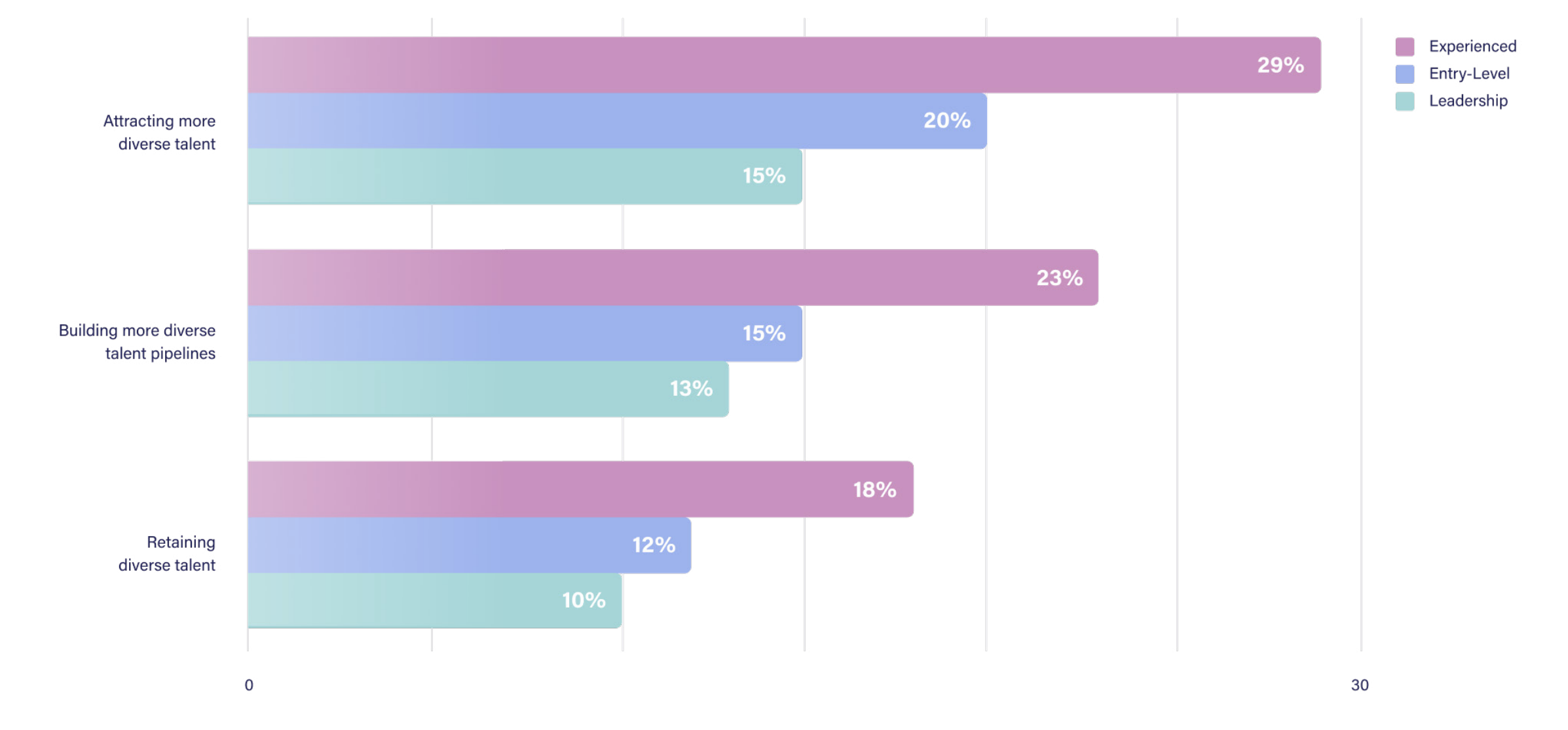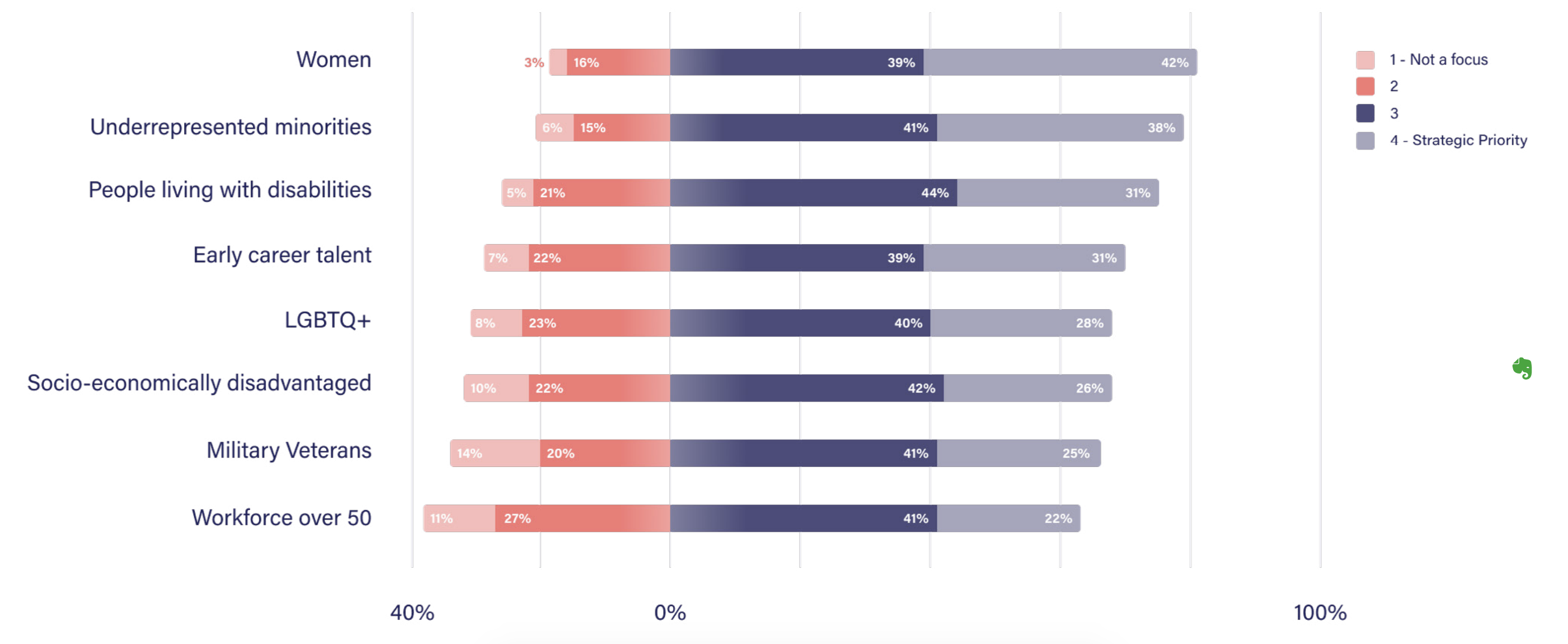Are Businesses Really Prioritizing DE&I in 2021?
If everything is a priority, then nothing really is.
That seems to apply strongly to Diversity, Equity and Inclusion agendas this year. While 2020 ignited a new sense of urgency in many companies around this subject, 2021 might not deliver all the promised results.
Over three quarters of companies in our survey rated every aspect of DE&I listed as a priority—with differences of a single percent between foundational work like formalizing DE&I talent strategies, and more focused initiatives like achieving gender balance in senior leadership. Is this lack of clear prioritization something that people leaders should watch for to ensure their DEI agendas end up delivering on their full value?
To bring more clarity to this question, we did a quick round-up of the results of our recent survey of talent and people leaders from 400 enterprises, published in the State of Diversity, Equity and Inclusion in Talent Transformation.
Some of these data points are encouraging, but others point to possible future points of failure. As a talent leader, you will probably be more interested in those, but it’s also important to recognize the positive forces of change that are in play.
Clear ownership is necessary for intentional execution
Diversity, equity and inclusion agendas can cover a wide spectrum of goals and objectives. What you do to facilitate the inclusion of minorities in your workforce will be very different from the changes you’ll make to provide equitable chances at progression and learning. Your talent team might form diverse interview panels or use technology to root out unconscious biases, but that might not be enough to retain diverse candidates in the long run.
Most organizations in our survey are focusing on broad tactics, like fostering an inclusive work environment (88%) and ensuring talent processes are equitable for all (86%), and a staggering 93% of CEOs cited fostering an inclusive environment as a priority. But, if everything is a priority, does that mean that most organizations have very little idea of what exactly they should be prioritizing?
DEI agendas can be extremely broad, and business leaders are sometimes tempted to keep them that way in an effort to please everyone. But let’s imagine what would happen if they applied that logic to the rest of their business decision-making. Does it sound like a good idea to try and do everything at once with finite resources?
A good first step when trying to decide what to prioritize and when to start is to enable one person to own that prioritization decision. While C-suite execs need to be vocal about their support of this work, and to have an actual opinion on how it should go, it’s important to have a dedicated leader for the DEI agenda. If no one owns it, then no one is accountable for it.

The drivers of DE&I agendas go beyond compliance
Less than 1 in 3 organizations cited compliance as a primary reason for prioritizing DE&I at this time. That’s not to say it’s not important—especially as global regulations continue to evolve in scope and complexity. But people are thinking bigger than compliance in DEI these days, and that is a good thing.

It’s also reassuring to see the competitive value of diversity so firmly entrenched in people’s minds. The research behind this has been around for almost a decade now, but it took a little while to be accepted as common knowledge that a more diverse and inclusive workforce directly correlates with performance and profits.
The extra DE&I challenge for experienced talent
Attracting and retaining diverse talent is a challenge for a large portion of companies, but that challenge is even more pronounced when it comes to experienced hires. 64% of organizations surveyed reported that attracting diverse talent is a challenge, compared to 51% that reported challenges with building diverse pipelines (internal or external) and 40% for retaining diverse talent. But within those different aspects of DEI agendas, experienced talent is even harder to reach.

This is good news from at least one perspective. If People organizations are looking for a place to start with maximum impact, this is certainly a good one.
Beware the generational shift
A few things to note when it comes to DE&I and generational shifts. Who is in the workforce today influences what matters, of course. But that can mean both good and bad things.
One one hand, the presence of more Gen Z in the workforce means that it is no longer enough to have good intentions as a company when it comes to DE&I. The same people who were protesting against racial discrimination across college campuses 5 years ago are now on the job market. And if, as college students, they demanded tangible change going from campus rules to university leadership appointments, they are unlikely to be satisfied with less as employees.
On the other hand, this change in the generational components of the current workforce has some less obvious repercussions. Workforce over 50 remains a priority for 63% of orgs surveyed, but this demographic was the lowest priority group overall. Less than 1 in 4 listed this demographic as a strategic priority. Could it be that the less vocal, older baby boomer generation is neglected in DEI agendas when there are louder voices in the room?

The year ahead will present a fair share of challenges to people teams and to their DEI agendas, but there are some good reasons to be optimistic. In our survey, only 16% of survey respondents reported a lack of ability to execute as one of their greatest obstacles to more meaningful and impactful DEI strategies. In other words, these teams feel like they have the skills and motivation in place to make things happen, as long as the organizational support around them follows.
The biggest barrier to impact, in our opinion, will remain the lack of clarity on where to start. It’s a scary commitment to make for most business leaders when it comes to a subject as charged as DE&I. But ultimately, the only way to deliver results when we have finite resources at our disposal, is to make a focused choice, and start somewhere.
Learn more about how Beamery powers more equitable talent outcomes.